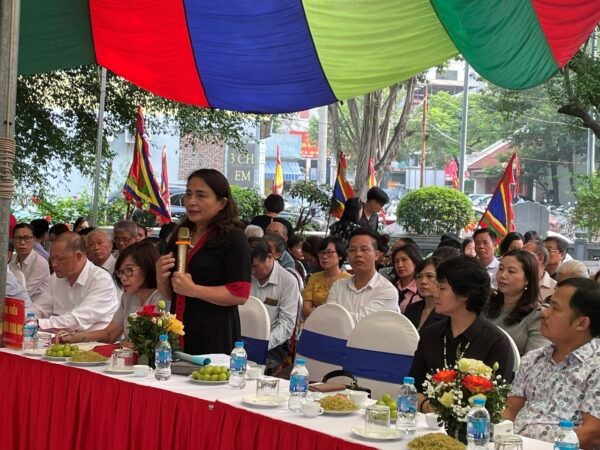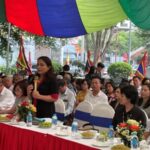The implemented solutions reflect a sincere commitment with the desire for traditional festivals in the inner-city region to become a valuable asset contributing to the development of the cultural industry in the Capital.
For the first time, the seminar “Preserving and Promoting the Value of Traditional Festivals in the Inner-city of Hanoi Today” has garnered attention from numerous experts and researchers in the cultural heritage field, representatives from the Ministry of Culture, Sports and Tourism, various research institutes, universities with relevant departments on cultural heritage, as well as leaders and specialists from the People’s Committees, Department of Culture and Information of the 12 districts. Representatives from the practicing community of cultural heritage in these 12 districts also participated.
The inner-city area of Hanoi comprises 12 districts with 221 traditional festivals. Notably, Ba Dinh district has 19 festivals, Thanh Xuan has 4, Tay Ho has 9, Nam Tu Liem has 23, Long Bien has 34, Hoang Mai has 9, Hoan Kiem has 10, Hai Ba Trung has 9, Ha Dong has 46, Dong Da has 18, Cau Giay has 16, and Nam Tu Liem has 24 festivals. Among them, 9 out of the 19 traditional festivals in Hanoi have been listed in the National Intangible Cultural Heritage inventory, including Le Mat Village Festival, Truong Lam Communal House Festival (Long Bien district), Chem Communal House Festival (Bac Tu Liem district), Dam Swimming Festival (Bac Tu Liem district), Lang Pagoda Festival in Dong Da district, Thi Cam Rice Cooking Festival (Nam Tu Liem district), Phu My-Kieu Mai Unity Festival (Nam Tu Liem, Bac Tu Liem districts), Moc Village Annual Festival (Thanh Xuan, Nam Tu Liem districts), and Dong Co Temple Faith and Filial Oath Ceremony (Tay Ho district).
Based on the practical organization of festivals in the inner-city region, the seminar has received numerous contributions and proposed solutions for traditional festivals to become a resource contributing to the development of the cultural industry in the Capital.
Dr. Dinh Viet Ha from the Institute of Cultural Studies (Vietnam Academy of Social Sciences) stated, “To realize the vision of a creative city, Hanoi has been actively constructing and implementing various projects, contributing to the formation of modern infrastructure and developing creative spaces. Currently, Hanoi leads the country in the number of creative spaces and is actively building innovation centers, a smart city, and a cultural fund… to exploit and transform cultural resources into the strength and impetus for the development of the Capital. Within the festival spaces, unique handicraft products from craft villages will be displayed and introduced to tourists, stimulating consumption. Cultural service activities during festival occasions not only meet the needs of tourists but also contribute to promoting many traditional handicraft and culinary brands of Hanoi, introducing the unique cultural features of Hanoi and creating opportunities for exchanging, trading goods, and increasing income for the people. Well-organized cultural services will enrich the content of festival activities.”


Cultural heritage experts and researchers expressed enthusiastic opinions.
To enhance the organization and maximize the value of traditional festivals in the inner-city area, Dr. Dinh Viet Ha suggests improving the efficiency of management and organization of festivals within Hanoi’s inner-city. Additionally, there is a need for financial investment, systematizing the entire festival operation, and categorizing each type of festival for effective management, guidance, and appropriate activity organization. Typically, large-scale festivals often take place in the spring. Therefore, meticulous preparation of a tourist map is crucial to gathering representative festivals within Hanoi’s inner-city, allowing visitors to attend and participate in festival activities. Since the implementation of the project “Research on the Organization of Festivals in the Old Quarter and Hoan Kiem Lake Area,” more domestic and international tourists have visited this area. Hence, it is essential to maintain and expand the achievements of this scheme.

A representative from the Office of Culture and Information of Dong Da District spoke at the seminar.


A representative from the community practicing cultural heritage also expressed opinions.
According to the representative from the Office of Culture and Information of Dong Da District, the coordination between state management agencies and the community is crucial for organizing traditional festivals. The successful reconstruction of the traditional procession ceremony of Saint Lang has created a vibrant atmosphere, touching the hearts of Dong Da residents and the people of Hanoi. It attracted significant contributions from the local community, agencies, as well as volunteers who actively supported the event. The festival forged a unity bloc among residents of districts, including Dong Da, Thanh Xuan, Cau Giay, and Ba Dinh. The success of organizing the Lang Pagoda Festival is attributed to the leadership’s attention and guidance, the involvement of the Ministry of Culture, Sports and Tourism, the City People’s Committee, relevant departments and agencies, the participation and contribution of researchers, scientists, the comprehensive involvement of Party committees, governments at all levels, and the effective coordination of the Fatherland Front and political-social organizations in the district. Media organizations and, notably, the active and enthusiastic participation of the local community played a vital role, emphasizing the role of the people as the main actors in festival activities.
Master Hoang Thi Thu Hang, from the Institute of Cultural Studies at the Vietnam Academy of Social Sciences, offers insightful perspectives on the integration of traditional festivals in Hanoi with tourism development. According to her, “It is evident that traditional festivals, through their diversity, richness, and uniqueness, constitute a significant resource for tourism development. However, when the relationship between traditional festivals and tourism is better understood and tightly integrated, this resource can be optimally utilized, resulting in genuine effectiveness. Traditional festivals become more vibrant, expandable, and financially rewarding when coupled with tourism. Simultaneously, tourism gains dynamism, depth, and allure when rooted in unique cultural values such as traditional festivals. Nevertheless, a traditional festival itself may struggle to become an attractive tourism product without the involvement of tourism professionals. Similarly, tourism may face challenges in development without a solid foundation in cultural values, including traditional festivals. This emphasizes the need for a strong and mutually beneficial connection between the custodians of traditional festivals and the tourism industry, driven by shared long-term goals. Only through such collaboration can the resources of traditional festivals be effectively harnessed for tourism development.”
Drawing from the practical example of organizing the Thap Tam Trai festival, a major event in the inner-city of Hanoi that attracts residents from 13 villages in Ba Dinh and Dong Da districts, Mr. Tran Son Tra, Deputy Head of the Management Board for the Historical Site of Nui Sua temple, proposes strategies to maximize the value of traditional festivals: Party and government leadership, along with the cultural sector, should express interest through specific documents and regulations to create a legal framework for regularly organizing festivals as traditions. The cultural sector should collaborate with local authorities and management boards to collect research materials and develop a comprehensive and standardized festival project. District leaders within Thap Tam Trai should actively participate, with increased enthusiasm and attention. Widespread dissemination of the historical significance and value of the festival to the general public, encouraging understanding, affection, and active participation. Respect the opinions and traditions of Thap Tam trai residents, as they are the core of the festival. Local festivals are rooted in tradition and local spaces, necessitating a respectful approach. Organizing more forums and field trips to festivals in areas outside the inner-city for management teams in Thap Tam trai to enhance knowledge exchange and experiential learning, especially from villages with shared cultural practices, such as those worshiping the tutelary god.
In the face of the urbanization process, the cultural environment of traditional festivals in the inner city of Hanoi is experiencing notable impacts and significant transformations. Against the backdrop of globalization and the rapid integration of the socio-economic and cultural aspects of nations, the restoration and promotion of traditional festivals play a crucial role in preserving and fortifying the resilience of indigenous cultures. This effort contributes to the conservation, enrichment, and amplification of the national culture.

